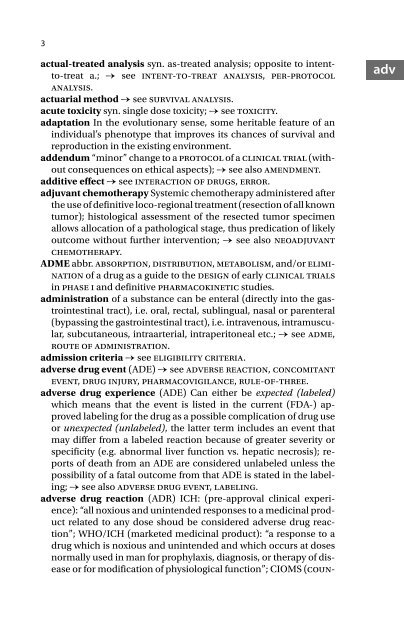220-Dictionary of Pharmaceutical Medicine, 2nd Edition-Gerhard Nahler Annette Mollet-3211898352-S
220-Dictionary of Pharmaceutical Medicine, 2nd Edition-Gerhard Nahler Annette Mollet-3211898352-S
220-Dictionary of Pharmaceutical Medicine, 2nd Edition-Gerhard Nahler Annette Mollet-3211898352-S
Create successful ePaper yourself
Turn your PDF publications into a flip-book with our unique Google optimized e-Paper software.
3actual-treated analysis syn. as-treated analysis; opposite to intentto-treata.; → see intent-to-treat analysis, per-protocolanalysis.actuarial method → see survival analysis.acute toxicity syn. single dose toxicity; → see toxicity.adaptation In the evolutionary sense, some heritable feature <strong>of</strong> anindividual’s phenotype that improves its chances <strong>of</strong> survival andreproduction in the existing environment.addendum “minor” change to a protocol <strong>of</strong> a clinical trial (withoutconsequences on ethical aspects); → see also amendment.additive effect → see interaction <strong>of</strong> drugs, error.adjuvant chemotherapy Systemic chemotherapy administered afterthe use <strong>of</strong> definitive loco-regional treatment (resection <strong>of</strong> all knowntumor); histological assessment <strong>of</strong> the resected tumor specimenallows allocation <strong>of</strong> a pathological stage, thus predication <strong>of</strong> likelyoutcome without further intervention; → see also neoadjuvantchemotherapy.ADME abbr. absorption, distribution, metabolism, and/or elimination<strong>of</strong> a drug as a guide to the design <strong>of</strong> early clinical trialsin phase i and definitive pharmacokinetic studies.administration <strong>of</strong> a substance can be enteral (directly into the gastrointestinaltract), i.e. oral, rectal, sublingual, nasal or parenteral(bypassing the gastrointestinal tract), i.e. intravenous, intramuscular,subcutaneous, intraarterial, intraperitoneal etc.; → see adme,route <strong>of</strong> administration.admission criteria → see eligibility criteria.adverse drug event (ADE) → see adverse reaction, concomitantevent, drug injury, pharmacovigilance, rule-<strong>of</strong>-three.adverse drug experience (ADE) Can either be expected (labeled)which means that the event is listed in the current (FDA-) approvedlabeling for the drug as a possible complication <strong>of</strong> drug useor unexpected (unlabeled), the latter term includes an event thatmay differ from a labeled reaction because <strong>of</strong> greater severity orspecificity (e.g. abnormal liver function vs. hepatic necrosis); reports<strong>of</strong> death from an ADE are considered unlabeled unless thepossibility <strong>of</strong> a fatal outcome from that ADE is stated in the labeling;→ see also adverse drug event, labeling.adverse drug reaction (ADR) ICH: (pre-approval clinical experience):“all noxious and unintended responses to a medicinal productrelated to any dose shoud be considered adverse drug reaction”;WHO/ICH (marketed medicinal product): “a response to adrug which is noxious and unintended and which occurs at dosesnormally used in man for prophylaxis, diagnosis, or therapy <strong>of</strong> diseaseor for modification <strong>of</strong> physiological function”; CIOMS (coun-adv


